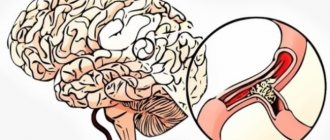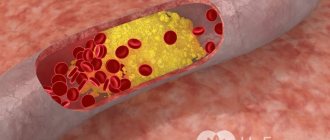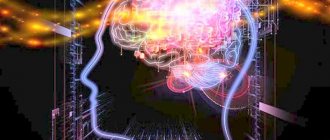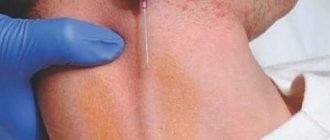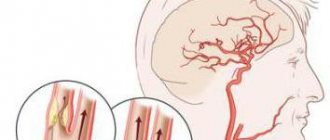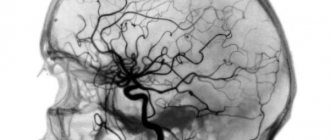Atherosclerosis is a common pathology and is characterized by impaired blood flow in vessels as a result of the formation of atherosclerotic plaques on their inner surface. The disease can be asymptomatic for a long time, but then it will certainly manifest itself as serious problems.
If the pathology is identified in a timely manner, then treatment of atherosclerosis of the vessels of the lower extremities, heart, and brain can be carried out using conservative therapy. Otherwise, surgery will be required. Medicines are prescribed by a doctor after completing all diagnostic procedures.
Features of drug therapy
As the patient’s condition changes, a treatment regimen is selected
The outcome of treatment depends on the speed of decision-making on drug selection. Medications can reduce the intensity of symptoms and normalize the condition of blood vessels. Their intake provides protection against further destruction of vascular walls. Drugs for atherosclerosis help achieve the following effect:
- restoration of blood flow;
- normalization of the patient's condition;
- strengthening blood vessels and endothelial cells;
- reducing the level of bad cholesterol in the body;
- increased production of endothelial cells;
- maintaining the integrity of atherosclerotic plaques (preventing the formation of blood clots).
Drug therapy involves an integrated approach. It is necessary to take several drugs at once in a adjusted dosage, selected individually. Selecting pills for atherosclerosis on your own is strictly prohibited. This will lead to a worsening of the existing situation. As the patient's condition changes, a new treatment regimen is selected.
On a note! Without diet and lifestyle changes, drug therapy will not be effective enough.
Forecast and consequences
The prognosis for patients with cerebral atherosclerosis is ambiguous. The following factors play a role:
- Age;
- Stage of the disease;
- Timely start of treatment;
- Eliminating risk factors, following recommendations;
- Accompanying illnesses.
If the patient consults a doctor on time and immediately begins treatment, he has a chance to keep the disease under control. At the same time, the quality of life will not deteriorate.
However, without treatment and if recommendations are ignored, complications follow.
Ischemic stroke. Atherosclerotic plaques predispose to the formation of blood clots. The blood clot blocks the lumen, blood does not flow, and part of the cerebral cortex dies.
This type of stroke develops gradually, often after previous transient ischemic attacks. Often occurs during sleep. The patient wakes up with a headache, weakness, and numbness of the limbs. His speech is impaired. Neurological symptoms subsequently appear.
Symptoms:
- loss of sensitivity on one half of the face;
- paralysis of one half of the face;
- vision problems: patients see “floaters” in front of their eyes, flashes of light, double objects;
- unsteady gait;
- general weakness, numbness of the limbs.
If you have such signs, you should immediately consult a doctor. He will conduct a differential diagnosis. An ischemic stroke is similar to a cerebral hemorrhage. An error in diagnosis will cost the patient his life.
Treatment will be immediately prescribed to minimize the area of necrosis of the cerebral cortex. To determine the affected area, MRI and CT with contrast are performed.
After a stroke, patients need recovery and return to normal life. The Yusupov Hospital has a rehabilitation clinic with high-quality equipment, where stroke patients receive the necessary care. Rehabilitation methods:
- Kinesitherapy;
- Massotherapy;
- Biofeedback method;
- Electromyostimulation.
Vascular dementia. As a result of atherosclerosis, the blood vessels of the brain narrow. Less blood flows. Due to lack of blood supply to the brain, its functions are impaired. The first signs of vascular dementia: memory loss, disorientation, decreased concentration. The patient does not remember recent events and confuses names. At the same time, he realizes that he has become forgetful.
At this stage, it is important to start treatment as soon as possible, as the symptoms will continue to increase and changes in the mental sphere will become irreversible.
Statins
During treatment with statins, it is recommended to monitor liver function
Statins are drugs that inhibit the activity of 3-hydroxy-3methylglutargyl-coenzyme-a-reductase. It is an enzyme that promotes the production of cholesterol. Taking statins blocks this process, reducing the amount of bad cholesterol in the blood. Medicines have the following effects on the body:
- the inflammatory process is eliminated;
- the likelihood of thrombosis formation is reduced;
- the functioning of the vascular endothelium improves;
- the process of movement of smooth muscle cells slows down;
- cell adhesion is prevented.
Statins are also prescribed to prevent Alzheimer's disease. After their use, the risk of cancer formation is significantly reduced. The most effective medications in this series include Lovastatin, Atorvastatin and Simvastatin.
During treatment with statins, it is recommended to monitor liver function. If ALT, AST and bilirubin increase, it is necessary to select a replacement with a similar effect. Side effects of this group of medications include:
- muscle pain;
- nausea;
- fast fatiguability;
- blurred vision.
Combating cerebral atherosclerosis
This disease causes many unpleasant and painful phenomena, such as severe headaches, mental disorders and sleep disturbances. People with this diagnosis often feel decreased performance, fatigue, dizziness, and suffer a noticeable decrease in memory.
Atherosclerosis in an advanced stage causes some slowness in movements, failures in coordination and negatively affects the clarity of speech.
In these cases, patients require radical measures to reduce cholesterol and complex treatment. It includes:
- Drug therapy;
- The strictest diet;
- Physiotherapy;
- Therapeutic gymnastics.
In order to prevent negative consequences associated with clogged blood vessels, a number of preventive measures must be followed.
Fibrates
Medicine for vascular atherosclerosis indicates the need to take fibrates. The most common of them is Fenofibrate. It reduces cholesterol levels in the body by 25%. The maximum concentration of the active substance in the blood is observed 5 hours after taking the tablet. Fenofibrate is taken with food. In acute pancreatitis, liver disease, photosensitivity and allergic reactions, the drug should be discarded.
The effect of the drug is due to the content of fibric acid. It removes harmful lipoproteins from the body and promotes the process of fat breakdown. Fenofibrate is used as part of complex therapy and as an independent agent.
Principles of drug treatment of atherosclerosis
The disease is characterized by the formation of atherosclerotic plaques on the inner wall of the arteries, which narrow their lumen and prevent normal blood flow. Most often, this pathology occurs in men over 40 years of age. Let us consider on the basis of atherosclerotic lesions of the vessels of the lower extremities.
Through the terminal aorta, femoral, iliac and popliteal arteries, oxygen and nutrients, along with blood, enter the tissues of the lower extremities. If the patency of these vessels is impaired due to the narrowing of the lumen by cholesterol deposits, the circulation of the legs is impaired, and in this case they speak of atherosclerosis.
When plaque becomes too large, it can break away from the vessel wall, causing damage to the inner layer of the artery. In addition, blood clots appear at the site of damage, which further narrow the lumen of the blood vessels. At the beginning of the development of atherosclerosis, a person may feel pain in the legs that appears during intense physical activity.
With a pronounced atherosclerotic process, the pain will be more intense and can also be disturbing at rest. In addition, atherosclerosis of the legs manifests itself with such signs as numbness of the feet, pallor and cyanosis of the skin on the leg, night cramps, trophic changes in the skin, intermittent claudication, cyanosis of the skin.
Advanced atherosclerosis is dangerous for the development of gangrene and limb amputation. Since this vascular disease is chronic, it is impossible to completely cure it. With the help of drug treatment, you can only stop the process of formation of cholesterol plaques. To do this, you need to reduce cholesterol levels in the blood and improve the condition of the vascular wall. If there is a pathological change in blood parameters, it is important to bring them back to normal.
Drug therapy for arterial atherosclerosis is aimed at:
- reduction in the intensity of symptoms;
- decreased levels of low-density lipoproteins in the blood;
- preventing the deposition of lipids on the internal vascular wall;
- improvement of the general condition of blood vessels;
- normalization of fat metabolism;
- restoration of blood flow in blood vessels and arteries;
- preventing blood clots;
- stabilization of cholesterol plaques.
Drug treatment of atherosclerosis is carried out at an early stage of the disease. For patients with this disease, it is important to stabilize blood pressure and lower glucose levels if there is a history of diabetes mellitus. The primary goal in the treatment of atherosclerosis should be normalization of cholesterol levels in the blood.
Is it possible to cure atherosclerosis?
For the conservative treatment of this disease, several groups of drugs are used:
- platelet antiplatelet agents;
- vasoactive drugs of complex action;
- direct anticoagulants to reduce blood clotting;
- bile acid sequestrants;
- statins;
- fibrates;
- prostaglandins;
- nicotinic acid preparations;
- metabolism stimulants.
Atherosclerosis requires complex treatment
Nicotinate group
Tablets are taken after meals
Nicotinic acid preparations for atherosclerosis increase the level of high-density lipoproteins. These include Enduracin and Niacin. The advantages of such medicines include their budget cost. The tablets are taken after meals with plenty of water. The optimal daily dosage is 3 g. Side effects of treatment include fever, headaches, epigastric discomfort and impaired liver function.
Main groups of drugs for treating the disease
Depending on the degree of vascular damage, third-party diseases, the patient’s condition and individual contraindications, the attending physician prescribes drugs from several groups:
- statins;
- fibrates;
- a nicotinic acid;
- ion exchange sequestrants;
- hypolipid drugs;
- anticoagulants;
- antiplatelet agents;
- antioxidants.
At the early stage of plaque formation, either statins or fibrates are sufficient for effective treatment. However, as the disease develops, it is impossible to cure atherosclerosis with only one group of drugs, so doctors combine drugs to obtain a favorable result.
Statins
This is the main group of drugs used for cerebral atherosclerosis and for preventive purposes. Statins or reductase inhibitors have lipid and non-lipid properties. The lipid-lowering effect is caused by the ability of the drug to lower total cholesterol by reducing LDL. The maximum level of LDL reduction depends on the dosage, and can reach 60%.
To reduce triglycerides, statins are prescribed if their content in the blood is no more than 4.4 mmol/l. During treatment, their level can be reduced by a third. If the content of triglycerides is high (over 10 mmol/l), the drug is prescribed in combination with fibrates and nicotinic acid. Complex therapy can increase HDL levels by 5-15% and halve the number of triglycerides.
Non-lipid manifestations of statins are:
- decreased activity of inflammatory mediators;
- reduction of oxidative processes of LDL and phospholipids;
- activation of the function of a single layer of cells;
- increased T-lymphocyte volume;
- improvement of bone condition;
- decreased lithogenicity of bile.
Statin drugs for the treatment of cerebral atherosclerosis have a positive effect on blood pressure and anticancer activity. However, it is not advisable to take them if liver disease is diagnosed, since the risk of developing liver failure increases.
Fibrates
The group of fibrates includes fibric acid derivatives. They are prescribed to reduce the liver's production of low and very low density lipoproteins, to prevent their spread and the emergence of new lesions. Tablets of the fibrate group have additional effects such as:
- stabilization of metabolism;
- removal of inflammatory processes;
- relieving emotional stress.
The simultaneous administration of fibrates, nicotinic acid and statins helps stop the development of pathology and reduces the mortality rate from heart attacks and strokes. The course of medication depends on the patient’s condition, and 2-3 tablets are usually prescribed per day.
Negative effects from taking include: nausea, vomiting, headache, diarrhea, migraine. Frequent and prolonged use can cause depression and leukopenia in the blood. Abuse also negatively affects the functioning of the heart and brain.
A nicotinic acid
The effect of nicotinic acid in cerebral atherosclerosis is as follows:
- lowering cholesterol, triglycerides and LDL levels;
- replenishment of niacin deficiency;
- stimulation of the cardiovascular system;
- decreased activity of fat breakdown;
- relieving dizziness;
- normalization of the central nervous system;
- vasodilation.
Medicines based on nicotinic acid form a group of vitamins B3, soluble in water. Regular use allows you to:
- prevent heart attacks;
- get rid of depression;
- improve the functioning of the gastrointestinal tract;
- restore sleep.
It is also prescribed for mild diabetes mellitus, stomach ulcers, poorly healing wounds, infectious diseases and inflammation of the small or large intestine. Side effects of the drug include redness of the skin, flushing of the face, and hypotension. Large doses can lead to fatty liver, diarrhea, vomiting, arrhythmia, and irritation of the gastrointestinal mucosa.
Ion exchange sequestrants
The main purpose of sequestrants is to bind bile acids in the intestines, preventing their reuse in the liver and accelerating the removal of acids from the body. After taking the drug, the consumption of total cholesterol increases, which leads to a decrease in LDL by 15-30%.
Cholestyramine and colestipol come in powder form, but it is insoluble in water and has an unpleasant taste. They are usually mixed with juice or washed down with plenty of water. Side effects occur only when the medication is not taken regularly and are expressed in digestive disorders. Overdose and taking the drug in large doses for a long time causes a violation of the absorption of fat-soluble vitamins and folic acid.
Sequestrants are recommended for patients with slightly elevated LDL levels or to prevent the development of atherosclerotic plaques. For persistently high cholesterol, they are prescribed in addition to statins.
Hypolipid drugs
Hypolipid group drugs include drugs that lower cholesterol levels without affecting triglycerides. They are prescribed in addition to statins, fibrates and a low-cholesterol diet.
Proburcol is prescribed to lower cholesterol by increasing the protein in the blood that delivers cholesterol to the liver with its subsequent removal from the body. Unsaturated fatty acids help reduce saturated fatty acids. The effectiveness of ezetrol is based on the uniform distribution of the main active ingredient on the intestinal villi, which leads to a decrease in the volume of fatty acids entering the stomach with food.
Pantheine activates oxidative and enzymatic processes, accelerates fatty acid metabolism and increases HDL levels. Lipomal prevents the absorption of fatty acids and the growth of cholesterol production in the liver.
Antiplatelet agents
This group of drugs is used to treat cerebral atherosclerosis and as a prophylactic against the formation of blood clots. Antiplatelet agents prevent platelets and red blood cells from combining and help increase blood fluidity. Antigout, vasodilator and antispasmodic medications are used as antiplatelet agents.
The mechanism of action of the drug is due to the ability to disrupt the metabolism of arachidonic acid, increase the intracellular level of cyclic amphetamine and affect the state of the cytoplasmic membrane of platelets.
Aspirin reduces platelet activity for a full life cycle of 7 to 10 days. This unique property is used to prevent thrombosis, stroke, and heart attack. Despite the benefits, prolonged or incorrect use of aspirin can cause complications:
- allergies up to Quincke's edema;
- anemia of posthemorrhagic, iron deficiency or hemolytic form;
- gastrointestinal pathology;
- bleeding gums;
- dizziness;
- hemorrhagic stroke;
- attacks of suffocation;
- acute renal or liver failure.
Glycine is classified as a vasodilator drug prescribed for atherosclerosis. Additionally, the drug strengthens the nervous system and improves brain function.
Anticoagulants
Blood clotting is important for protecting the body when the walls of blood vessels are damaged. When blood clots, it forms a clot that stops bleeding. Under certain circumstances, blood clots can also form inside a vessel. This pathological condition can lead to disruption of the functioning of an organ or system, and even to death.
Anticoagulants are medications for cerebral atherosclerosis that reduce the activity of the coagulation process and prevent thrombus formation. Their role in the treatment of pathology is great: direct-acting drugs reduce the activity of thrombin in the blood, and indirect-acting drugs reduce the formation of prothrombin.
Anticoagulant drugs have few side effects, and usually an overdose leads to severe headache, vomiting and nausea, and impaired kidney function.
Antioxidants
Antioxidant drugs correct the energy metabolism of the brain. The effectiveness of therapy for acute and chronic cerebrovascular processes has been proven by medical observations. All biological and artificial antioxidants are divided into 2 types: fat-soluble and water-soluble.
Among the fat-soluble ones, a-tocopherol is most often prescribed, which interacts with the hydroxyl radical OH and suppresses singlet oxygen. Water-soluble antioxidants include glutathione, which is necessary to protect cells from toxic oxygen intermediates. This group also includes ascorbic acid. It is involved in the stabilization of oxidative and reduction processes, in the process of blood clotting and carbohydrate metabolism.
Bile acid sequestrants
Bile acid sequestrants are prescribed if it is impossible to use statins, for example, if an allergic reaction develops. Among them are Colestipol and Cholestyramine. Their action is based on the ability to bind bile acids, which improve the absorption of fats in the digestive tract.
It is customary to take the capsule 4 hours before eating or an hour after it. The tablets have an unpleasant taste, so they should be washed down with any soft drink. A decrease in the manifestations of atherosclerosis is observed after a month of treatment. With prolonged use of the drug, the following side effects develop:
- digestive dysfunction;
- decreased supply of folic acid in the body;
- increased bleeding.
How dangerous is this disease?
As a result of poor circulation in the brain, a complication such as a stroke may occur.
With atherosclerotic blockages, the patient faces the following complications:
- Acute cerebrovascular accident. This medical term is more commonly known as stroke. When it occurs, there is a blockage of the vascular lumen of the main arteries that supply the gray matter with a thrombus or embolus. Large areas of the brain die and are no longer restored.
- Encephalopathy. It is also called senile dementia. This is a phenomenon of chronic ischemia of cortical structures as a result of occlusion of the vascular lumen.
- Chronic migraine headaches. They also develop in parallel with a decrease in neuronal oxygenation.
Omega-3 triglycerides
With long-term use, Omega-3 triglycerides prevent the formation of blood clots and activate the body's defenses
Drugs for the treatment of vascular atherosclerosis in this group prevent the development of heart attacks and strokes. These include Omacor, Anginorm, Eikonol, Vitrum-cardio and Fish oil. The main property of such drugs is the normalization of fat metabolism in the bloodstream. They also have antiplatelet and anti-inflammatory effects. With long-term use, Omega-3 triglycerides prevent the formation of blood clots and activate the body's defenses.
Penetrating into the gastrointestinal tract, omega-3-triglycerides bind to cholesterol and phospholipids in the form of free fatty acids. Once in the bloodstream, they are implanted into the membranes of vascular cells and change their structure.
Herbal remedies
Herbal medicines are distinguished by their natural composition and combined effects. The active ingredients are pumpkin seeds and oil. A striking example of such products is Ravisol. It is used to prevent vascular atherosclerosis. Thanks to saturated fatty acids and vitamin E, it has a lipid-lowering effect.
Ravisol is available in tincture format for oral administration. It is taken 3 times a day, before meals. The contents of the bottle should be shaken and diluted with water. The course of treatment should not exceed 10 days. In case of hypotension, renal pathologies and hypersensitivity to the constituent components, the use of the drug is prohibited.
Important! If you have diabetes mellitus, you should approach the choice of drug with extreme caution.
Combined products
If there are contraindications for combination drugs, an alternative replacement should be selected.
A drug for atherosclerosis of combined action not only normalizes lipid levels in the body, but also reduces blood pressure. Before use, medications used in treatment are analyzed for safety. If there are contraindications, an alternative replacement should be selected. The main combination drugs include:
- Azi-Ator;
- Caduet;
- Duplecore;
- Ineji;
- Biperine.
Other drugs
With pronounced manifestations of atherosclerosis, treatment is carried out with potent drugs. Their use is combined with the use of lipid-lowering agents. Such drugs include:
- Beta blockers that have a hypotensive effect. Among them are Metoprolol, Nebivolol and Atenolol.
- Angioprotectors that ensure the transport of nutrients to the tissues of the extremities. They reduce pain and normalize metabolic processes. These include Curantil, Pentoxifylline, Persantine and Trental.
- ACE inhibitors are micropreparations for atherosclerotic coronary artery. They lower blood pressure. The most common medications in this series include Lisiropril, Captopril and Sinopril.
- Antiplatelet agents include drugs based on acetylsalicylic acid. They are used to prevent thrombosis.
During the treatment process, it is necessary to periodically go for preventive examinations. Additionally, diagnostic procedures are performed to determine the effectiveness of therapy.

